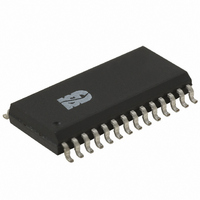ISD2575S Nuvoton Technology Corporation of America, ISD2575S Datasheet - Page 7

ISD2575S
Manufacturer Part Number
ISD2575S
Description
IC VOICE REC/PLAY 75SEC 28-SOIC
Manufacturer
Nuvoton Technology Corporation of America
Series
ISD2500r
Datasheet
1.ISD2560P.pdf
(43 pages)
Specifications of ISD2575S
Interface
Button/MCU
Filter Pass Band
2.7kHz
Duration
75 Sec
Mounting Type
Surface Mount
Package / Case
28-SOIC (0.300", 7.50mm Width)
Lead Free Status / RoHS Status
Contains lead / RoHS non-compliant
Available stocks
Company
Part Number
Manufacturer
Quantity
Price
Company:
Part Number:
ISD2575S
Manufacturer:
ISD
Quantity:
5 510
Part Number:
ISD2575S
Manufacturer:
ISD
Quantity:
20 000
PIN NAME
V
ANA OUT
MIC REF
CCA
ANA IN
AGC
MIC
, V
CCD
SOIC/
16, 28
PDIP
17
18
19
20
21
PIN NO.
TSOP
23, 7
24
25
26
27
28
Supply Voltage : To minimize noise, the analog and digital circuits
in the ISD2500 series devices use separate power busses. These
voltage busses are brought out to separate pins and should be tied
together as close to the supply as possible. In addition, these
supplies should be decoupled as close to the package as possible.
Microphone : The microphone pin transfers input signal to the on-
chip preamplifier. A built-in Automatic Gain Control (AGC) circuit
controls the gain of this preamplifier from –15 to 24dB. An external
microphone should be AC coupled to this pin via a series capacitor.
The capacitor value, together with the internal 10 KΩ resistance on
this pin, determines the low-frequency cutoff for the ISD2500 series
passband. See Winbond’s Application Information for additional
information on low-frequency cutoff calculation.
Microphone Reference : The MIC REF input is the inverting input
to the microphone preamplifier. This provides a noise-canceling or
common-mode rejection input to the device when connected to a
differential microphone.
Automatic Gain Control : The AGC dynamically adjusts the gain of
the preamplifier to compensate for the wide range of microphone
input levels. The AGC allows the full range of whispers to loud
sounds to be recorded with minimal distortion. The “attack” time is
determined by the time constant of a 5 KΩ internal resistance and
an external capacitor (C2 on the schematic of Figure 5 in section
11) connected from the AGC pin to V
“release” time is determined by the time constant of an external
resistor (R2) and an external capacitor (C2) connected in parallel
between the AGC pin and V
470 KΩ and 4.7 μF give satisfactory results in most cases.
Analog Input : The analog input transfers analog signal to the chip
for recording. For microphone inputs, the ANA OUT pin should be
connected via an external capacitor to the ANA IN pin. This
capacitor value, together with the 3.0 KΩ input impedance of ANA
IN, is selected to give additional cutoff at the low-frequency end of
the voice passband. If the desired input is derived from a source
other than a microphone, the signal can be fed, capacitively
coupled, into the ANA IN pin directly.
Analog Output : This pin provides the preamplifier output to the
user. The voltage gain of the preamplifier is determined by the
voltage level at the AGC pin.
- 7 -
FUNCTION
SSA
Publication Release Date: April 24, 2006
analog ground. Nominal values of
ISD2560/75/90/120
SSA
analog ground. The
Revision 1.2












